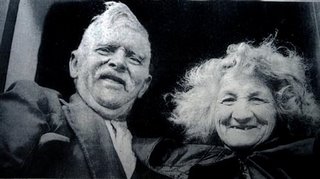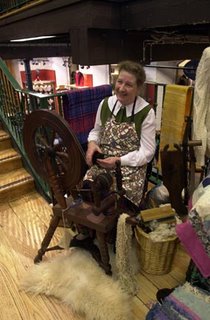Have you ever had that experience? You search high and low for something that you know perfectly well must be there, was there the last time you looked. And it isn't there. Of course the only thing to do is to say in a loud voice, 'Well, I didn't want it anyway,' and then go off and do something else. Even if your whole being is screaming with frustration and refusal to accept its absence, you have to pretend disinterest and leave the scene. When you nip back in, a couple of hours later, you can bet that the sought-after object will be sitting where you originally left it, only slightly out of breath and looking innocent. Maybe they go off on a world tour, perhaps they move into another dimension. I don't know. But my purple yarn doesn't want to come out and be seen tonight. OK. I'll catch it next time.
But in the meantime there are other things to talk about. First off, I promised to let you see the original old black and white picture of the Tailor and his wife, Ansty, dating from about 1940.

Aren't they a marvellous old couple? You can just see the crutch under his arm (he was always lame, from childhood), and Ansty is wearing her West Cork cloak in honour of the occasion. The one I was wearing the other night to spin by moonlight is a copy I made a few years ago. They were worn by all countrywomen right up to the early 20th century and were often handed down from mother to daughter, since they were expensive items, well made of fine broadcloth with a satin lining. The hood could be gathered to fit around the face or loosened to fall open on the shoulders in a capelet effect. You won't believe how I managed to make mine: I got the pattern from Folkweave in California. There was nowhere in Ireland I could have tracked down a pattern, since such cloaks were made by experienced tailors (like himself above) who would have had their own basic designs. But Folkweave are marvellous at finding classic old garments and working out the patterns from the actual garment. I think they call it the Kinsale Cloak, and others call it the Bandon or Macroom cloak, but it's the same thing.
Have you read Wanda's latest posting? She waxed so beautifully lyrical about walking in the countryside and picking blackberries that I gathered a couple of cans and hauled DH out this afternoon to do the same thing. There are so many different kinds of blackberry that you can pick fruit from mid August right up to October when the devil throws his cloak over them and they become too bitter to eat.

We gathered a huge amount and brought them home in triumph. I made two luscious blackberry pies for dinner and will make jam with the rest tomorrow. The season is on! No rest for the wicked from now on, with all the wild harvesting to be done.
If you're into spinning, then here's something to think about as you treadle the wheel peacefully this evening, enjoying the feeling of the fibres slipping through your fingers. There is a lady called Rosemary who demonstrates spinning at Blarney Woollen Mills, a tourist attraction near the famous Blarney Castle. She has spun and knitted all her life, learning from her mother who in turn learned from her mother, and all the way back, in the true traditional way.

Rosemary told me a strange tale about her grandparents, Tomas and Annie Glynn, who lived in Co. Mayo back in the troubled years of World War I, when Ireland was fighting for its own freedom.
At that time, she explained, the English used to come and take away the hotheaded young men to work in the Welsh coal mines. They needed the labour since their own young men were far away in the trenches; and they probably thought it was one way of keeping the Irish lads from conspiring against England back at home. Annie knew that her husband would in all likelihood be taken; she also knew how harsh conditions were in the Welsh mines. She had seen other young men come back crippled with frostbite, with lost limbs. And so she did the only thing she could - she taught him to spin, and then to knit sturdy warm socks.
Sure enough Tomas was taken away to Wales and sent to work in the mines in the freezing depths of winter. Conditions were appalling; but he had his secret weapon. Somehow he fashioned several spinning wheels out of bicycles - whether these were lying around or were pressed into service illegally, Rosemary didn't know and quite honestly, I would be of the opinion that all's fair in love and war. Then he taught the other men with him to collect wool from the sturdy Welsh sheep on the hillsides around, card it, and spin it. Finally he taught them how to knit socks as he himself had been taught by doughty Annie. Rosemary wasn't sure what they did for needles, but maybe they used spokes from the bicycle wheels. It might sound far-fetched in our time of double-glazing, central heating and year-round comfort, but that man's skills meant that those young Irishmen survived the war years in good warm caps, mittens and socks, and returned safe and whole to their families.
I remembered the story Rosemary had told me when I read the other day on Handmaiden's weblog about someone asking if it were true that mittens were considered very valuable in World War I. I can confirm that they certainly were - especially in the bitterly cold coal mines of Wales.
The story strengthened my belief that no-one has the right to put down, to denigrate the age-old skills of creating warm garments. It's an arrogance which might well rebound on the instigator. Imagine a man who scorned his wife's quiet knitting by the fire, suddenly finding himself lost on a hillside in fog with no warm clothes? Imagine - and this is probably far closer to home - a sudden dreadful catastrophe when comfort and security are urgently needed. Who then will be the most important - the computerised chief executive or the knitter of afghans? I am finding it increasingly hard to be accepting about today's attitude to these vital skills. Is it because they're mostly practised by women? Last year I wanted to write a preview on the Knit & Stitch Show which was coming to Dublin as well as the UK. 'Good Lord no, isn't that just knitting and things?' said the editor dismissively. I fumed, but went away murmuring the mantra, 'don't get mad, get even.' I went back next day full of manufactured excitement and enthusiasm about this great new 'fibre art' exhibition coming to Dublin. I showed him images too - one was of an entirely knitted bedroom suite, I think. 'Great,' he enthused. 'Let me have the story right away. Those art exhibits are wonderful!'
Yeah, I got my way by devious means. I just wish I could have got it the straight way. It's up to us to reclaim the status that our skills so clearly deserve. If I have to bang a few male heads together in the process, that's fine with me. How about you?









7 comments:
Very strong images come to me as I read your description of the coal mines,the coldness/darkness and spinning wheels being made from bicycle wheels and men knitting.Could be a scene from a movie.
Diane/Bloomington,In.USA
OOPS--knitting needles from bicycle wheels! Not spinning wheels.
Diane/Bloomington,In.USA
your banging male heads together to get what you wanted and my pretending to be the hysterical helpless woman to get my freezer yuck picked up yesterday instead of today sound like variations of a similar theme - we do what will work at the time to get the desired effect. heheheh I told DH what I stooped to to get the pick up yesterday and he had a good laugh about it - knowing how far from that hysterical helpless female I really am.
The Tailor looks like he could be a relative - which of course means he looks like a lovely person to me :D
I have put so many things in the perfect spot to keep them knowing I will know exactly where they would be when I need them -- I guess they must be off on world tours also because I still haven't found some of them
Since my children moved from home, more of my things tend to stay where I put them, although I still often have similar cases to yours, which is especially irksome when it's my glasses that have disappeared - adds the problem of not being able to see well enough to find them! After a big cleanup of my play, I mean work room, I came across a bag of yarns that I lost many years ago. It had been placed in a careful spot, but clearly a bit too careful for me.
I, too, have been surprised when I've added a glitzy element. I think of myself of the natural, simple, plain coloured sort of person, but maybe variety is that proverbial spice adding to life.
Here, in Australia, when I say to people at my ex-work that I'm filling my time with things like spinning and knitting, I often get a long 'Oh' in response, as though they can't work out how that would engross me so much. Mind you, I sometimes then get requests for commissions from them. I KIP at a local cafe once a month, and most of the other customers just give us a quick look, and then don't worry.
you GO girl!
i find that boys really like knitting a lot. the sum of the appealing tools, some problem-solving to work out, and a product to show for their troubles really appeals. and i also find that boys and men are overwhelmingly attracted to wool and yarn. they seem to find it very comforting.
ohio is the first place i lived though, where men are fascinated with spinning and knitting, but will not allow themselves to indulge.
i try and try, but they always demur. of course it doesn't stop me from trying.
A great move by the Govt. there Jo .Hopefully the Welsh mines were a hot-bed of socialism. Did you ever see a series called "When the Boat Comes In?" . It was set in Tyne and Wear and includes lots of social and political history including The Black and Tans. I don't know if they were volunteers as the ones portrayed are the biggest B*****ds .I should know more ,all English kids should know more.Holly is reading my huge "Socialist Verse" which includes a very sad poem by a member of a firing squad who having shot a member of The I.R.A writes a poem to the guys mother begging forgiveness for his ignorance.
Anyhow on lighter matters I think there are borrowers,house fairies or whatever who take things which they return if you ask nicely . Also patterns for old English smocks ..I keep meaning to search one out. I'd probably have to source good linen fron Eire. We have an agricultural museum in Reading that has some beauties. Part of your post just brings back my telling that council woman that wearing warm sweaters would mean turning down the thermostat and her face ....obvious to me. Holly saves my old Laura Ashley cats. and lusts after the Welsh wool suits they had and even beautiful long woollen stocking .I wore that in the 1980s but admit I walked everywhere as my parents had no car and neither have we .I makes you more aware of the elements.
What a wonderful post--as all of yours seem to be! My DH is always interested in learning about the history of knitting--especially male knitting. I'll pass this on to him.
(BTW--I am raising a couple of knitting males. Currently he is finishing the second of his first pair of socks! And my 7yo son is knitting his first scarf from yarn he spun himself.)
Post a Comment